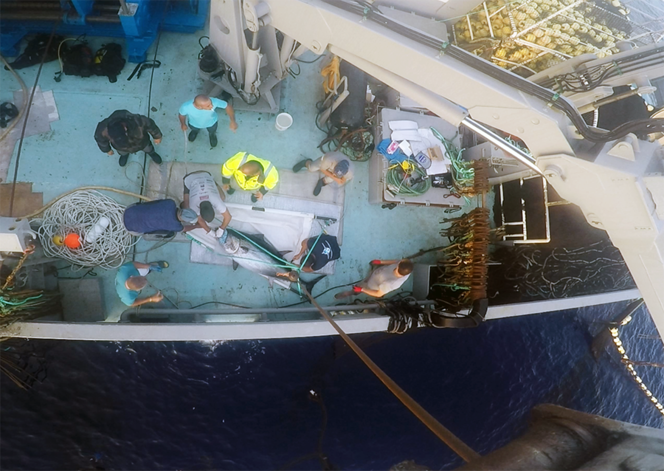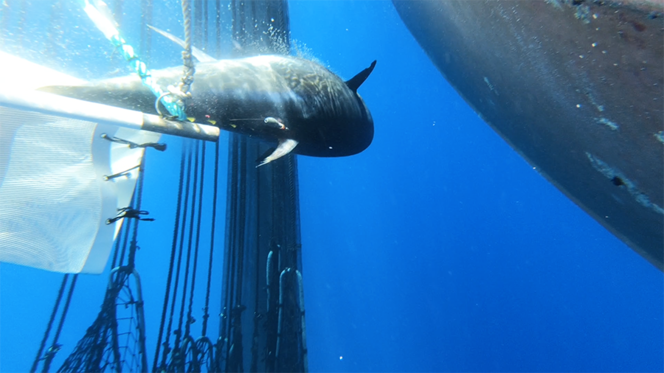Despite their size, weighing as much as hundreds of kilos, bluefin tuna are difficult to study. Researchers have developed instruments to monitor these animals’ migrations as well as various physiological parameters, including those linked to their reproduction.
Over the years the bluefin tuna has become emblematic of overfishing. In point of fact, the name is used to designate three different species: the Atlantic bluefin (Thunnus thynnus), the southern bluefin (Thunnus maccoyii) and the Pacific bluefin (Thunnus orientalis). Despite large-scale catches, little is known about the migration patterns of this fish, whose large size and high mobility make it difficult to monitor. Today a new research collaboration seeks to shed light on its dynamics and offer precious data for managing and protecting its populations. “The Atlantic bluefin tuna was overfished in the mid-1990s, but since 2012 its numbers have improved,” reports Tristan Rouyer, an IFREMER researcher at the Marine Biodiversity, Exploitation and Conservation (MARBEC) laboratory.1 “It’s an iconic species, with a life expectancy exceeding 40 years and a weight that can reach 700 to 800 kilos – the size of a cow.”
Another impressive characteristic of the Atlantic bluefin is its transatlantic migrations, whose role in its life cycle remains largely unknown. Scientists know that it breeds in specific zones of the Mediterranean, where 60% of the catches take place, and that it loses a lot of weight during that period. The fish then migrate to other waters including the Gulf of Lion and the Bay of Biscay, where they feed and regain strength. Some larger, hardier individuals travel much further north, all the way to the Norwegian and Canadian coasts, where the waters swarm with herring and mackerel. Tagging and monitoring systems are available, but they cost about €4,000 apiece – a price that prevents sufficient measurements to be carried out to obtain statistically significant quantities of data.
Going beyond geolocation
These instruments also have limited performance, only providing information on the animals’ location. For this reason, the IFREMER researchers sought out microelectronics experts to help them develop new solutions. “We went around all the laboratories in Montpellier southern France, and the response from the team at the Laboratory of Computer Science, Robotics and Microelectronics (LIRMM)2 was especially keen and well-informed,” Rouyer recounts. “We really hit it off with them, both on a scientific and personal level.”
The collaboration between the LIRMM and IFREMER led to seven projects for studying marine life, including turtles and billfish like marlin and swordfish in the Indian Ocean. Two of these schemes, dubbed FishNchip and Popstar, involved the development of a tag for geolocating tuna while gathering information on their physiological activities, all at a much lower cost. Another programme called Prompt focuses on the movements of Atlantic bluefins and the impact of climate change on their migration patterns. Popstar and FishNchip have a combined budget exceeding €3 million. “We wanted to make a new generation of electronic tags that collect more data for cheaper,” says Serge Bernard, a CNRS senior researcher at the LIRMM and the leader of the FishNchip project – a role that comes with its share of challenges due to the complexity of studying bluefin tuna.;

Adapting the system to movements and pressure
Using a low stimulation current, this system measures the impedance of organic tissues over a wide range of frequencies. The same principle is used in sophisticated scales that calculate fat mass and certain postoperative monitoring equipment. Impedance spectrometry can record multiple parameters, like muscle activity, an animal’s growth and the extent of its fat reserves. The sensor is a microelectronic device of a few square millimetres in size, connected to electrodes implanted into the tuna’s flesh. This type of detection is normally used on immobile subjects, but bluefin tuna are migrating animals, constantly on the move. Their muscular activity and the enormous pressure that reigns at depths as great as 1,000 metres also make the task more difficult.


Monitoring the breeders’ migration
In 2019 five tuna were tagged, and the results of that campaign will be published soon. In any case, the experience enabled the team to optimise their methods for catching and tagging the fish – an especially delicate operation, as it involves specimens weighing 200 kilogrammes. In seven minutes, a bluefin is caught, hoisted aboard, tagged precisely and securely before it is finally released, all without causing undue stress to the animal. “If the tag bothers it enough to change its natural behaviour, the data will be useless,” Bernard emphasises. One of the monitored subjects followed a migration pattern that sums up much of what was known about the bluefin’s migratory dynamics: it left the Mediterranean in July and crossed the Atlantic, reaching one of the preferred fishing zones for Japanese long liners, then returned to the Mediterranean. Such migratory routes had previously been identified piecemeal, but this study was the first to trace a complete cycle of a Mediterranean breeder.

The next campaign will introduce the new tags developed by the LIRMM and IFREMER, making it possible to observe how the bluefins’ physiology changes as they migrate. The lower cost per tag means that more individuals will be studied, which should yield more statistically significant results. Where and when do the fish gain and lose weight? Knowing their location and physical condition at the same time will provide excellent indicators of their biological cycles as well as any variations in those cycles, especially in response to climate change.
In the long term, the team hopes to make its instruments open-source, so that the international research community can use them to tag other animals less expensively. “Researchers are under a lot of pressure in terms of resource management, and they’re eager to have systems like ours,” Bernard says. “Otherwise there won’t be enough data to make informed decisions for the protection of wild species.”

